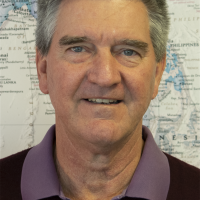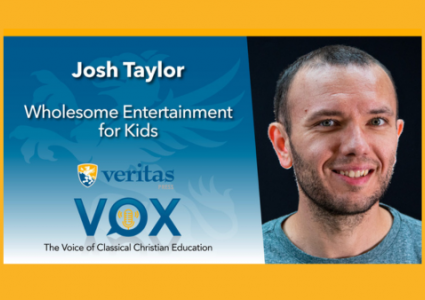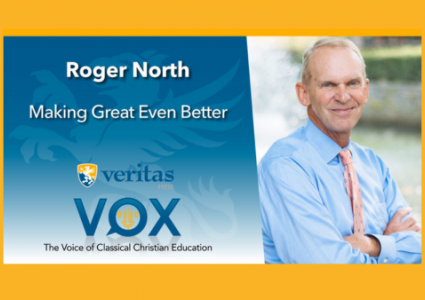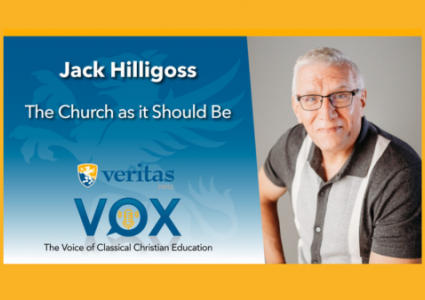STEM, Crucial to a Classical Education | Mitch Stokes
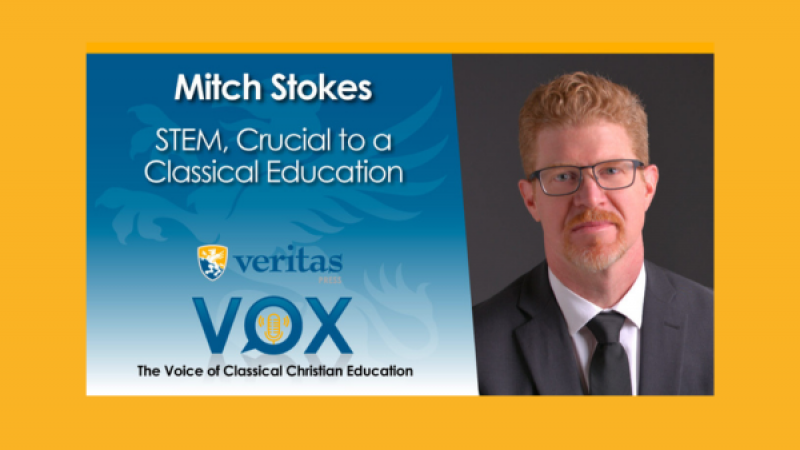
Listen on Apple Podcasts | Listen on Spotify | Watch the Video
Are STEM skills and a liberal arts education two completely different things? While they may seem separate at first glance, classical education blends them together beautifully - just like the early philosophers did! Today Mitch Stokes from New Saint Andrews College in Moscow Idaho joins us to discuss how he blends mathematics and philosophy as he teaches students in ways that are steeped in truth, goodness, and beauty.
Episode Transcription
Note: This transcription may vary from the words used in the original episode for better readability.
Marlin Detweiler:
Hello again. This is Marlin Detweiler. I'm here with Mitch Stokes, and you have joined us for Veritas Vox, the voice of classical Christian education. Mitch, welcome.
Mitch Stokes:
Thank you. Yeah, it's good to be here.
Marlin Detweiler:
Yeah, it's nice to have you. Tell us a little bit about yourself and your family as we get into the topic at hand today.
Mitch Stokes:
Yeah. So I started my career initially as an engineer, so I worked as an engineer for a number of years. That was my initial background and then left engineering, went back to school and studied religion and then philosophy. Got my Ph.D. in philosophy.
Marlin Detweiler:
Where did you do that?
Mitch Stokes:
Did some studies at a seminary in Orlando, Reformed Theological Seminary, then went to Yale and got an M.A. and religion there. Mostly philosophy religion, and then went to Notre Dame and got a Ph.D. in Philosophy there.
Marlin Detweiler:
Okay, very good. That's quite a set of credentials and has some nice breadth to it. That gives you a lot of context, I'm sure. And tell us a little bit about your family and where you are now career-wise.
Mitch Stokes:
So now we're in Moscow, Idaho. I've been teaching at New St. Andrew's College, a small liberal arts, classical ed college for, gosh, 18 years now. Amazing! So maybe part of the theme here is I'm old! We have grown kids of our own, four of them. The oldest is married with a baby on the way, and the youngest two are actually in college at New St. Andrew's.
Marlin Detweiler:
How many do you have total?
Mitch Stokes:
Four.
Marlin Detweiler:
Okay, very good!
Mitch Stokes:
And we have a wedding next week.
Marlin Detweiler:
So only one's married so far.
Mitch Stokes:
Yes.
Marlin Detweiler:
Very good. Tell us what you teach there. New St Andrew's is known to many of our many people in the audience and would be known as a liberal arts school, but you don't teach in the liberal arts areas, do you?
Mitch Stokes:
Well, that's almost like that's a trick question there! Kind of the point that some of the things that I'm trying to do when we're trying to do, and I think you guys are part of this as well, is to integrate the sciences and humanities and what we normally call the liberal arts and not do it in an ad hoc or hokey way. You know, for a math class, you don't just, do word problems, but that you call people, you know, you say “Well Augustine did was–” You don't do it in a hokey way. You do it in a natural way. And a big part of what we do and what I do, particularly at NSA, is teach the history and philosophy of science in mathematics. And it's really– what when I teach theology and apologetics as well. And oftentimes, what's interesting is it's really difficult to categorize the course. When you're looking for Philosophy 101 or whatever it is you're looking for, the prefix for the course title, it's really difficult to figure out, okay, is this a math class, or is it a philosophy class?
Well, I'm also doing theology. You know, we talk about hermeneutics and interpretation. So it's really – and I think that's a good problem to have. That should be something, something that we're not necessarily trying to fix. And so, yeah, I mean, I'll teach everything from philosophy, history of philosophy, epistemology, the study of knowledge, apologetics, hermeneutics, interpretation of scripture.
What are the rules of theology? How do you know what's the right interpretation? And we can do all this sometimes in a single course.
Marlin Detweiler:
We at Veritas, we have a curriculum that we call the Omnibus. For credits purposes. It covers history, theology, and literature. But when somebody asks me to describe it, I say it is intended to be a course where students read the Great Books in order to think biblically about anything and everything.
Mitch Stokes:
Yeah, no, that's great.
Marlin Detweiler:
That sounds like that's what you're talking about.
Mitch Stokes:
Yeah. And in fact, I've done a couple of the articles in those books. So yeah, I think that's absolutely right.
Marlin Detweiler:
Well, focusing on the sometimes watertight distinctions that we make between STEM and the liberal arts, let's at least start with some common ground here for the listener. How does STEM- science, technology, engineering, and math. How does that become significant in the context of a real liberal arts education?
Mitch Stokes:
Yeah, no, it's it's funny. It's it's actually the integration of STEM and the humanities or what we normally take as the typical liberal arts is actually baked into the idea of the liberal arts and the classical education, and this goes all the way back to the inauguration of our classical Western liberal arts tradition that started with, you know, essentially started with Plato in his republic.
He introduces the proper education, what he thinks is the proper education for the philosopher kings. And in addition to the disciplines that we call the Trivium, now, he introduces what we now call the Quadrivium. And he says that primarily the Quadrivium, which consists of arithmetic, geometry, astronomy, and music or music and harmony. He says that that's really key to training people to think clearly and then be able to actually lead the city-state in his context.
And then later that that was also part of training for theology and not just philosophy, but theology in the Christian tradition. And so this Quadrivium is really just the Pythagorean division of mathematics; the way he thought of arithmetic, geometry, astronomy, and music isn't exactly the way we do.
We think, okay, well, because we're so used to just thinking of it a certain way, we think, “Well, that's what he meant.” And he meant something deeper. He thought. I mean, the whole idea and what was central to his philosophy, and again, I think, remember, this is Plato. This is, you know, I mean, one famous philosopher, some scientists, and mathematician sums them up this way, you know, all of European philosophy to pretty much be characterized as a footnote to Plato.
And there is something to that. There's something it's amazing about how many of the questions, the answers that he provided set the agenda for the West. So Plato is important. That's my point there. And that he introduces ideas. He introduces the traditional liberal arts education to the West. And in doing that, he actually– the whole assumption for him is that the world, the universe, the physical cosmos, is mathematical, fundamentally, and so is the human soul.
And he thinks that studying that, studying mathematics, studying how it applies to the universe, can actually help guide your soul and be purified. So for him, it's kind of this what theologians would call sanctification, you know, for this kind of secular.
Marlin Detweiler:
Becomes spiritual sanctification.
Mitch Stokes:
Yeah, yeah. Which is really, really interesting that he thought – and again it's not necessarily that we have to think that exact thing, but there's something deep there, namely that there is the universe, and he even thought this that the this the reason that the universe is mathematical and it applies to both the human. You know, there's a place for humans as an integral part of that is because he believed that there was a God who created it that way.
So God designed it to be orderly and rational, a mathematical but not just rational and mathematical in the way we think about it. He also thinks, and this is very, very important, that it's beautiful. So beauty was just an enormously important criteria for him when it came to what the world is like. Even the notion of cosmos, we get that might even have been coined by the Pythagoreans before him from that he learned from part of what that means is not just a rational, orderly universe, but also a beautiful universe, because, I mean, that's where we get cosmetic, the word cosmetic from.
So you have this and so remember, when you know, we want to tell our kids this. Remember when you're signing up for classes– don't mistake cosmetology and cosmology, you'll get different credits. But they do have a root in this notion of beauty and in this you can see in his the fact that he includes music or harmony as part of that tradition, you know, part of the Quadrivium.
He wouldn't even have thought that rational mathematical and beauty would come apart, that when that just wasn't on the table, but we're seeing it.
Marlin Detweiler:
When did that happen? Do you know?
Mitch Stokes:
It – when did he…?
Marlin Detweiler:
In the development of thought and educational theory and practice when did it happen that those two became separate?
Mitch Stokes:
Yeah. No that's that's a – trying to give a non simplistic answer. You know, causes are you know there's a lot of different causes and different episodes in history were that separated in spurts. Certainly, one of the things that where it really happened was– started to happen– is the scientific revolution and this notion of– in order to understand the cosmos mathematically. So it's kind of this irony in fulfilling this sort of Plato's platonic vision of understanding the universe mathematically, which is what the scientific revolution part of what that's what it was doing. So it was kind of like a Platonic dream being fulfilled. Yet at the same time, in order to tackle that enormous problem, they kind of had to separate out some of the more fundamental mathematics, like what Aristotle would have called natures or forms, things that made and just focus on the math.
Look, don't worry about what's causing things to fall. Let's just characterize the falling objects with mathematics, because that's enough for now. So there's this separation of duties in order to tackle the problem because just part of it is so difficult, then they never kind of come back together. And so you have this that's where the real breakout is.
And then after World War II, it happens again in spades.
Marlin Detweiler:
Yeah, but we see a real departmentalization of the subjects, the disciplines of it's, you know, math classes on one side of the hallway and then biology is on the other, and they don't touch. And we at Veritas, we saw that as problematic and wanted to do something about it with what we have done. So how does that impact what you teach at New St. Andrew's?
What does it look like for a history of mathematics or a philosophy of mathematics class? And I may get those titles wrong, so feel free to correct me. What does it look like? You know, a third of the way through the year?
Mitch Stokes:
Yeah, that's good. So we do start with ancient Greece and some of the things that I was just explaining to set up the themes that go along through that. I will say this too. What we end up doing at the end with contemporary physics and philosophy, and let me just say real quickly, the there's a crisis right now in physics, in contemporary physics, where the two main theories in physics are quantum mechanics and general relativity. But those two don't fit together. They work well in their spheres. Again, there's kind of a siloing there and a segregation. But when you try to put them together, they don't. They disagree and they contradict one another in certain ways. And so the next thing is trying to come up with a theory that combines a unified theory of everything.
The point here is we don't have a lot of data to go on because it's so expensive to get, difficult to get, so there's a big scramble and debate over what do we do next, you know, where do we direct all of our attention? And, you know, right now it's sort of “should we go with string theory?” and all that.
But the point is, it's a debate over whether or not we should follow beauty and use beauty as a criterion to judge whether a theory is good. So you're basically using beauty and aesthetic judgments in physics to guide you as an indicator of where to go. But some people –
Marlin Detweiler:
It's hard for me to grasp that. And maybe for our listeners, can you give us something that we can grab a hold of with that?
Mitch Stokes:
Yeah, sure. So and this is one of the things that, you know, again, if we had more time, we could set this up. But Einstein and some of the real visionaries of the early 20th century were explicit about how beauty guided their thinking. So they want a theory that is beautiful, it's simple, and they have all these different ways of characterizing beauty.
But when you don't have data, you can't go, okay, well, let's check the data. And if you're coming up with a theory you don't have, you can't look at the world. How do you know it's the right one? Well, you can't check the world. So what Einstein did before they even before he could check and do experiments, he had to just figure out, “Am I on the right track? I think so, because this is really a beautiful theory.”
And so for years he used that criteria for guiding his very thought. And it's a very, you know, beauty we think is very, very fair. And that's something that's ethereal. And you can't really apply it to something like physics and math. It's like, well, actually, Einstein did it and set this trend that actually goes back to Plato. And now there's a debate, though, because they're not sure it's working. Anyway. So we get to that and we show that theme. But what does it look like, say, a third of the way through? Well, it was funny yesterday we were talking about how in the 1600s, there was this– because of the scientific revolution and the Reformation and the Counter-Reformation, there was this concern about who to believe.
Like, okay, we've been wrong about the earth moving. That seems like a big thing to get wrong. The church is split. I mean, they're disagreeing over scripture. There's some trust issues here. And so people are worried, and they call that skepticism, worried about like, “Okay, what can we believe?” Well, there was an anti skeptical push in the 1600s. We can't have people going around doubting this, that, and the other. We're losing our foundations. Well, one of the things they do is they turn well, the thing they do is they turn to mathematics as a guide to anchor, because you think, well, mathematics is certain like that. You look at Euclid in that way of thinking, we can't get into that.
But the way of thinking is so fundamental to the West and to the way we think now. You even see this in one of the Protestant confessions, the Westminster Confession of Faith. They take a page out of the Mathematician's book in the Westminster right at the front, when they're talking about the Bible, and they say, look, here's how you go about it, the way the mathematicians do.
So we're covering this in this history and philosophy of math and science course and talking about as we're talking about the Counter-Reformation and what's going on. And then next week, what we'll do is we'll look at how Descartes is actually countering skepticism with mathematics; that’s his goal. We usually think of Descartes as the ultimate skeptic. He's actually an anti-skeptic. And he says, look, we're going to use mathematics. That way of thinking and that way of building the system to halt the skepticism.
Marlin Detweiler:
Interesting. Interesting. The idea of your basic biology, chemistry, physics, you know, what we might call the three pillars of science connecting to a broader liberal arts education. What does that look like as you see this thinking applied? Obviously, there's a basic grammar of chemistry, grammar of biology, grammar of physics kind of thing that fits into our pedagogical model even for the older student taking them for the first time in a serious way.
But how does that all incorporate as you develop your thinking, and what does it mean to the businessman dad or the housewife Mom?
Mitch Stokes:
Yeah, that's a that's an excellent question. Well, I think you're absolutely right. You say, look, when you – the solution isn't to get rid of the rigor and the grammar or kind of, you know, let's not do that. It's like, well, the problem is much worse than that. That would be too easy. And it would be and it would be wrong.
But the first thing you need to do is to make sure that you do understand the grammar the – without that, you're not going to be able to build the deeper things– you need that. But if you stop there and you say, okay, let's look at how in biology, let's look at how the cell works or how the immune system in a human, whatever it is, and you just stop there.
Well, I mean, first of all, that's necessary. But don't if you stop there, you really aren't stepping back and seeing the whole point. Now, the question is, how do you step back and see your whole point? Do you just go, “Oh, and look, this is a wonderful God, designed this wonderfully.” Now I say, I don't mean that's exactly what we should be saying, but there's much more to it.
And a lot of it has to do with the fact that the sciences used to be called natural philosophy and natural philosophy, actually. So all of a sudden we should be thinking, okay, there's something going on that's a little bit different. You know, we don't call it natural philosophy now for a reason, but it was because it was philosophy and part of philosophy.
And you're studying that part of the cosmos, whether it's organisms or, you know, the chemical aspect or whatever, you know, atoms or whatever it is. But it was in order to understand the universe and to understand the human place in the universe, there's a great picture that summarizes this of woodcarving and I would encourage the listeners to look for this. It is called the Flamarian Engraving, and it shows a– it basically I use it to show students, giving them a visual picture of what philosophy and humans are just trying to do when they're learning.
They're trying to, they're looking at the world and all the things that appear to everybody, every culture and everything. And they want to know what's going on behind the scenes, what you know, what is making this work this way? What is our place? They're trying to answer the big questions. And so you–- science is actually a part of answering those big questions because so, for example, if you get– think about the brain, you know, I mean, obviously, that's amazing.
You know, an amazingly designed organism or organ and but there's something more to it there. How do you get this physical brain to do some things that don't seem entirely physical, like the fact that we can – we're self-aware, you know, we can think about our thoughts.
Marlin Detweiler:
You mean I can touch my nose without missing because of how my brain operates, that kind of thing?
Mitch Stokes:
Yeah. That's part of it. But there's even more, there's this sense of, you know, thoughts like you think, okay, well, thoughts of that. We know what a thought is. But when you really start trying to figure out how the brain produces thoughts or even what thoughts are, it's very difficult to see how a brain, a physical firing of neurons in this, you know, complex chunk of meat in your head could actually produce something that seems immaterial like a thought.
And so anyways, forget about whether, you know, the details of that. The whole point is that there's this big – this goes back to Plato even again and through Descartes into the West, where you kind of have this view of a physical body like your brain and the rest of you, and then a soul or a mind. So you have these two things and what some people are trying to do today, particularly in cognitive science, and say, no, there's not that soul immaterial part.
It's just all physical meat, and right there you have in cognitive science this discussion of Plato's dualism of body and soul as a going concern. So that's just one example. And I think for each branch of science, you know, they come back together, and it's it's great to separate them into branches as long as we don't take it too far, each is going to have their different way of connecting to this big picture.
But the thing is, is that it should be natural for us to do that. But the real question is how to do that in an efficient way where students are getting the facts in the right– not all facts are created equal. So you need the high-yield things. So think whether they're going on to be a doctor or a cognitive scientist or not, it's the education that someone like Veritas is providing.
As you know, it's to prepare folks for either direction and meaningful for both of them. So there's got to be – it's not like falling off a log to come up with an education or curriculum for these kinds of things. And that's the work that you guys have been doing for years and years. And then you of all people you're dealing with it, you know the struggle and the how to get this depth.
Without sacrificing some of the other things that we value like yeah if you go when you go on to college to be an engineer, you darn well better know your calculus by the time you get in there.
Marlin Detweiler:
Well, speaking of calculus, we're running out of time here, and I want to give you a chance to plug a little bit. You wrote a calculus text. It's fairly new. When was it published?
Mitch Stokes:
A couple of years ago.
Marlin Detweiler:
It's a couple of years old. Okay. I didn’t think it was that old. That'll tell us why you wrote a calculus text for a K-12 world.
Mitch Stokes:
Yeah, it was really – so as I went around speaking to different schools and educational conferences and things like that, I would talk about this integration of math and science and the liberal arts. And, you know, I was doing this in my own teaching, but people would say, okay, “Hey, this is great, I’m on board. So what would you recommend I use?”
And I'd have to say, “I don't really have anything right now. I know how I would do it myself.” So really a lot of it has to do with me wanting to get this out there as an example of the kind of thing that I have in mind. So not just tell people, show them, you know, So it's show not tell, not just tell.
And so it really it was one of those examples. And so I have this plan. Okay. The two things that I think are central and really high-yield and really designed to integrate STEM and humanities is Euclid's elements and calculus because the stories of them all go back to the roots of Western philosophy in the liberal arts themselves.
Calculus is really just kind of a manifestation of Plato's philosophy. He would be like, This is what I want my academy to do when I charge them to. I want them to do calculus.” So a lot of it was to give people– here's an example. Now it happens to be ironically, calculus is one of the easier ways to do this because it's so central to Plato's project.
So I kind of on the one hand, started with something easy, but then also because it's calculus with something hard. And so what I did is to make it again, it's hard to know, is this calculus, is this math, is this history? Is it philosophy? Well, I wanted to show how that can be done, I hope, in a natural way that will allow STEM people to see it. You know, it wouldn't be in lieu of a normal calculus class, but at the same time, it gives you the core of calculus limits, derivatives, integrals, fundamental theorem, like stuff that I wish as an engineer. I was like, “Man, I wish I had known that was what was going on when I was doing those high-level courses. I wish I had that framework.” And so part of it is to give that framework in that foundation for later calculus courses. But if someone doesn't go on to a calculus course, that's totally fine too. That's not the point. The point is to get them to see that and to get into the nuts and bolts of how this story plays out.
Marlin Detweiler:
That's wonderful. Well, we have run out of time. You have clearly, there's a lot we could talk about. You have really, I hope, whetted the appetite of people, especially to try and understand that STEM is not something that sits alongside and separated from the liberal arts tradition, but rather is born out of it and connected to it inextricably. Did I say that right?
Mitch Stokes:
I think so, yeah.
Marlin Detweiler:
And we've got to realize that the kind of education we want to deliver in a classical education is much broader than what we've typically understood in a very narrow way to be a liberal arts education. Thank you for your work in what you're doing.
Mitch Stokes:
Really I appreciate you having me on your podcast, and thank you for all your work. You've done this. You've been working diligently at this for a long time, and it's been a real blessing to a lot of people.
Marlin Detweiler:
Oh, thank you. It has been a long time, and sometimes we feel tired from it. Folks, today we have had Mitch Stokes with us on Veritas Vox, the voice of classical Christian education. Thank you for joining us.



